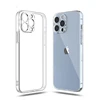Premium smartphone manufacturers have been steadily improving battery life for years, and Apple is no exception. In fact, if you only look at the improvement of the current iPhones compared to last year’s models, you may not realize just how far they’ve come.
The battery in today’s new iPhones lasts several times longer than that of the iPhone X introduced just seven years ago! Fortunately, we have been testing iPhone battery life in the same way since then, so we wanted to illustrate just how much better iPhone battery life has become.
iPhone battery life over the years
We have tested battery life using the Geekbench 4 battery life test going all the way back to the iPhone 8 and iPhone X. We perform the test the same way each time, setting screen brightness to 200 nits and disabling all notifications and auto-brightness settings. We then run the test with the “dim screen” feature turned off to maintain consistent brightness.
The Geekbench 4 battery test runs the Geekbench 4 benchmarks repeatedly on a loop until the battery dies, with a small break between runs. It’s a way to keep the screen active and the processor occupied in a consistent fashion over an extended period. It is, however, a little dated—the more modern Geekbench 5 and Geekbench 6 unfortunately did not include a battery benchmark.
Here’s how long each of the regular iPhones lasted during this test. There are two tabs on this chart, one showing battery life (in minutes) and one showing the capacity of the battery (in milliamp hours).
You can see a clear and impressive increase in battery life over time. Battery capacity has grown a lot, almost doubling from the iPhone 8 to the latest iPhone 16. But battery life has extended much more than that, with the iPhone 16 running this same test, at the same brightness, lasting over five times as long as the iPhone 8! Bear in mind that screen size has increased quite a bit over this time, too.
Also read: iPhone batteries compared – Capacity, mah and watt hours for every iPhone
Taking a look at the “large” model phones, we see a similar story: an increase in battery capacity, but a much bigger increase in battery life. There are fewer phones to consider here, as the iPhone XR and iPhone 11 had no larger variant, and the iPhone 12 and 13 had a “mini” model instead of a larger one.
Pro iPhones shine even brighter
The iPhone Pro models are known for often having slightly longer battery life, in part because they may use newer or more advanced components that are more efficient. Here’s how long the iPhone Pro models last, along with the battery capacity in mAh. While the iPhone X and XS don’t carry the “Pro” name, they’re included here as they were clearly the pro models of their release year.
Starting with the iPhone XS, Apple produced a larger Max model that always had a larger display and a larger battery. Here’s how they compare. You can see only a modest increase in battery capacity over the last five years, but a more than doubling of battery life.
Whether Pro or not, large or standard, Apple’s battery life gains have dramatically outpaced the bigger battery capacities. In other words, efficiency is going way up.
iPhones are now more than twice as efficient
We can easily derive a sort of basic “efficiency score” when we divide battery capacity (in milliamp-hours) by battery life (in minutes).
The result is a mAh per minute score that lets you know how much battery is being used to run the phone for one minute during these tests: meaning, brightness stuck at 200 nits on a mostly-white screen (with a bit of colored and black text), running Geekbench 4 tests on a loop.
For this value, lower scores are better, as it means less battery capacity is being used per minute.
The iPhone Pro models are almost always just a touch more efficient than their non-pro siblings, with a notable exception of the iPhone XS being a little less efficient than the iPhone XR. But no matter how you slice it, iPhone power efficiency has become steadily better over time, even as performance has gone way up and displays have become larger and brighter.
Now let’s take a look at the large-size phones.
Again, the Pro phones are slightly more efficient than their non-Pro equivalents, but the big story is the absolutely huge improvement in overall power efficiency in the last seven years.
What is the cause of this efficiency improvement? It’s undoubtedly difficult to pin down. There have been improvements in iOS over the years, but also in the low-level microcode that controls everything in your iPhone from USB and Lightning ports to haptics and NFC. Wireless radios have improved, from Wi-Fi to Bluetooth to 5G to NFC. Display technology keeps improving, offering not only better quality and higher brightness but also the ability to turn power into photons with greater efficiency. And of course, the main application processor and supporting chips continue to evolve not just to offer better performance but to use less power. That means A-series Apple Silicon, RAM, power regulation circuitry, and so on.
The impressive and steady efficiency gains of the iPhone line over the least near-decade come in little drips and drops—a few percent here, a fraction of a percent there—until they all add up to a downpour. It’s the compound interest of mobile power efficiency, and we are all the beneficiaries of it.
Still, we can’t help but notice the stark improvement in this year’s iPhones, even relative to just the year before. Not since the iPhone 11 to iPhone 12 generation has overall power efficiency improved this much in one year. But unlike that generational leap, where iPhone battery capacity went down, this year the efficiency leap was paired with larger batteries. No wonder the iPhone 16 line is delivering the longest battery life ever in an iPhone by such a wide margin.





